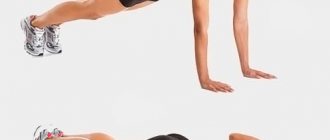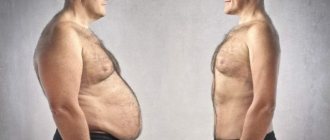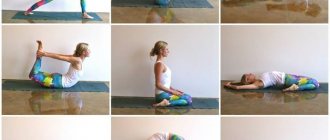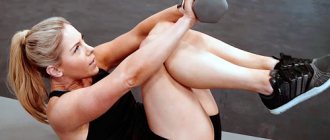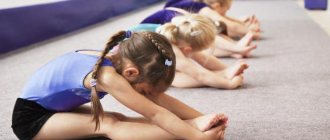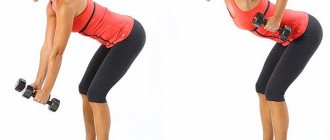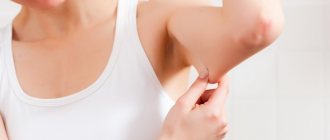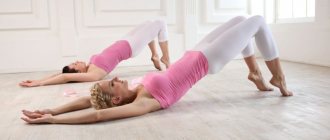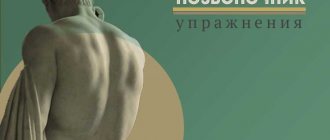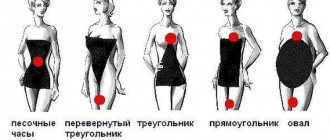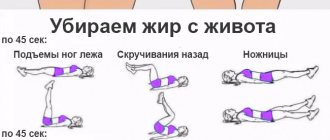Treatment
Treatment of stooping involves an integrated approach, which depends on the patient’s age and the degree of development of the disease.
Here are the main ways:
- Swimming. Swimming can stop the development of pathology. In water, the spine takes the correct position and is loaded naturally. To correct posture, crawl and breaststroke exercises are prescribed to relax the chest and abdominal muscles, as well as strengthen the back.
- Manual therapy. The use of this technique for a stooped back is indicated if there is pain and displacement of the vertebrae. It is prescribed in parallel with a complex of exercise therapy to consolidate the therapeutic effect.
- Physiotherapy. Procedures using heat, electromagnetic waves, mud, ultrasound, electrophoresis lead to the following effects: increase metabolism; normalize blood supply; eliminate pain and inflammation.
- Corsets and posture correctors. The use of this type of posture correction occurs as prescribed and observed by a doctor to: fix the spine in the correct position; relieving muscle tension; unloading the ridge; activation of muscle work. They wear corsets and posture correctors during breaks between performing therapeutic exercises for no more than 6 hours a day. It is contraindicated to increase the time of use on your own, so as not to provoke muscle atrophy.
- Massage. When treating stoop, massage is used together with exercise therapy as an auxiliary method. It improves blood circulation and relieves tissue swelling.
- Exercise therapy. Therapeutic exercises are the main method of eliminating the causes of stoop. The correct selection of exercises helps strengthen the back muscles and relax the chest and abdominal muscles. Read more in the article: “Exercises for stooping.”
Determining the correct body position
Posture is determined by how a person is used to sitting, standing, or holding his body while walking. It is considered correct if a person walks without tension, with his head raised. The line of the shoulders is straight, they are straightened and slightly lowered down.
The protruding belly is not visible, the legs are straight at the knees. A natural deflection on a flat back is noticeable.
Method of determining posture:
- stand on a flat surface and press the back of your head, shoulder blades, buttocks and heels to it;
- stand on straight legs so that it is comfortable, without achieving correctness;
- when the palm passes freely between the lower back and back, we can assume that everything is normal.
Otherwise, there are problems with the spine.
The reason why the connectionfailure error appears on your computer
It may seem strange to inexperienced users that when using certain web resources, connection errors periodically occur. That is, you cannot access this site at this time. But at the same time, you can easily find yourself on Yandex or Photostrana, but you cannot go to VKontakte or Facebook. We would like to warn you right away that the host file, which can contain malicious code that restricts access to servers, is not clogged and nothing needs to be changed or formatted. This error does not symbolize the presence of viruses on your PC, so the antivirus is also powerless here. The reasons for this problem are the following:
- Blocking access to the site by a firewall (firewall).
- There is no connection between the site and the server.
- Antivirus blocking access to the site.
- Failure of settings/changes of settings on the part of the provider.
Naturally, we assume that you are using a Windows OS and therefore the only firewall that may interfere with you is a stock firewall. Why might he be blocking access to the site? Perhaps in the signatures for updating the firewall, and it is updated very often, a message appeared with the url of this site stating that it is malicious and so on. The only option that can help in “fighting” the firewall is to enable/disable the firewall. In this case, the signatures will be loaded already updated and this may help solve the problem.
There may be no connection with the server if the site has temporarily crashed or maintenance work is being carried out. Most website owners create a special page to which the user is redirected when the resource is being repaired or refilled. But there was one case in the summer of 2014 - the social network VKontakte was “lost”. None of the users could log into VK, and many questions appeared on the Internet about connectionfailure and how to fix this phenomenon in the browser. By the way, it may happen that the site will open in one browser, but not in another. Reinstalling the “non-working” web page browser will help you here. In the case of an antivirus, downloading new virus signatures will help you, a procedure similar to a firewall. This is how you can trigger Avast signature update:
If you have reached point 4 of the reasons why a connectionfailure error may occur, then you need to contact your provider to find out details about the status of the service.
We hope that you understood the essence of the problem that is associated with the connectionfailure error and found a solution based on the proposed options.
Bow pose (dhanurasana).
If you look at the body of a person in this position, it really resembles the shape of a bow, where the hands act as a bowstring, stretching the legs, torso and head upward.
1. While lying on your stomach, bend your legs at the knee joints and clasp your shins with your hands (outside or inside).
2. Straightening your legs and lifting them off the ground, pull yourself with your arms, stretching your spine from your pelvis to the top of your head. Repeat 5 times.
Working the spine straightens hunched shoulders and back. The bow pose is also used to treat certain types of rheumatism.
Why is slouching dangerous?
Stooping cannot be considered an independent disease, but its treatment is important to improve a person’s quality of life. Good posture gives you a feeling of confidence and helps maintain a good mood.
For most, this does not matter and poor posture remains unattended until the first symptoms of complications appear.
If stoop is left untreated, an adult may develop the following pathologies:
- posture disorders;
- degenerative changes in the spine (osteochondrosis, hernia);
- systemic pathologies (osteoporosis, rheumatism or rheumatoid arthritis).
Each disease has its own symptoms and affects the patient’s well-being to varying degrees.
Poor posture
Violation of posture is discussed when changes recorded instrumentally (x-ray) are detected. Before changes in bone and cartilage tissue, the curvature is functional in nature and completely disappears in the supine position or when the muscles rest.
Poor posture can cause pain in the spine and stiffness of the thoracic region.
Possible manifestations:
- impaired sensitivity and decreased strength in the legs, less often in the arms;
- difficulty in movement: with advanced curvature, there is a complete restriction of mobility in the thoracic region;
- feeling tired and back pain;
- difficulty in blood circulation;
- displacement of the vertebrae relative to their axis;
- poor circulation creates the preconditions for the occurrence of Schmorl's hernia or osteochondrosis;
- development of diabetes.
The absence of measures to correct stooping in an adult leads to further progression of the pathology. Due to the depletion of nutrition of bone and cartilage tissue, degenerative changes begin that can cause disability.
Complications of degenerative changes
Destruction of the intervertebral disc leads to pinching of nerve fibers, which manifests itself in severe pain. Over time, pain is accompanied by various symptoms from changes in sensitivity to loss of muscle strength in the limbs. The most serious disorders begin with a long chronic course and can significantly reduce the patient’s quality of life and even shorten its duration.
Slouching can cause osteochondrosis.
Signs of a complicated course of destructive changes:
- Poor circulation in the cervical region leads to dizziness, headaches, decreased memory, vision, and hearing.
- Disorders in the functioning of internal organs: shortness of breath, palpitations, disturbances in the functioning of the gastrointestinal tract.
- Severe pain can become permanent.
In advanced cases, all internal organs and systems suffer. To prevent a disastrous outcome, the disease should be treated at the very beginning, in this case at the stage of stoop formation.
Manual therapy and its effectiveness
Manual therapy is considered one of the most effective methods of treating stooped posture in patients over 25 years of age. Manual therapy is considered alternative medicine, however, manual techniques are widely used in orthopedics, sports medicine and neurology. It is necessary to seek the help of chiropractors only in medical institutions and specialized centers that are licensed to engage in this type of activity.
Manual therapy is a treatment system that, using hands, allows treatment of the spine and joints, disorders in the muscle system
The most effective manual techniques and their characteristics are shown in the table below.
Table. Manual therapy methods for the treatment of stoop.
| Method | What it is? |
| Acupuncture | Method of influencing the body with medicinal needles. Needles are inserted under the skin at special points on the body with maximum accumulation of biological energy. The method is widely used in China to treat pathologies of the musculoskeletal system and in this country belongs to traditional medicine. |
| Acupressure | This is a type of reflexology that involves applying pressure (pressure) to biologically active points and irritating them. |
| Craniosacral therapy | A method of treating back problems using your hands without using force or pressure. |
| Shiatsu massage | A method of practical manual therapy based on the anatomical and physiological theory of circulation. |
The cost of one session of manual therapy for problems with posture in adults starts from 2000 rubles. To achieve a stable result, it may take from 3 to 10 sessions.
Manual therapy
Causes
It is worth noting the reasons for stoop:
- Creating a workplace without taking into account individual characteristics.
- Problems of a psychological nature.
- Scoliosis.
- Physical inactivity.
- Underdeveloped chest and back muscles.
- Minor physical activity.
- Ailments with the spine that appeared at birth.
- Back injury.
- Polymyelitis and rickets.
A hunched back in childhood and adolescence is the result of low mobility and constant sitting. In the modern world, there is a sharp decline in active leisure options. This is due to the emergence of new gadgets. Children began to devote less time to sports.
In adults
Posture is created in early childhood. But some shortcomings appear at a later age. Discomfort manifests itself when safety precautions are not followed in the gym and when there is heavy strain on the chest muscles. The occurrence of stoop occurs against the background of various diseases.
In adults, stooping occurs for the following reasons:
- Prolonged sitting. Many professions require office work. You need to be in a sitting position for a long time. This affects muscle weakness and uneven posture.
- Muscle imbalance causes weakness in the muscles. The development of stooping aggravates poor posture.
- The psychological factor often manifests itself in tall people.
- Spinal diseases manifest themselves in the form of osteochondrosis, osteoporosis and spondylosis.
Slouching in a child
Stooping manifests itself in childhood as a result of the following reasons:
Low activity. Because children sit at the computer for a long time. Muscles weaken quickly. Rapid growth provokes elongation of the spine, but the back muscles cannot keep up with the growth of the spine. They stop supporting their back. Psychological problems - complexes, the desire to become invisible and fear of contact with peers. A sign of scoliosis is stooping
It is important to consult an orthopedist.
Children also experience joint hypermobility syndrome. The disease is manifested by high flexibility of the spinal column. Slouching causes the spine to bend outward.
Slouching in a teenager
Slouching often appears during adolescence. At the first symptoms, you need to consult a doctor who will prescribe effective treatment.
After the examination, the cause of the stoop is determined. Physical activity will be an excellent addition to the main treatment. Massage for stooping and various physical procedures may be prescribed.
Why do we slouch and what does it lead to?
Before we find out whether it is possible to correct slouching at 30, let's find out why such a problem occurs. Rounded shoulders appear as a result of poor posture.
Lack of physical activity provokes muscle problems in adulthood. The scapular muscle weakens and the chest muscles contract. This also leads to hunchback. Correct posture helps solve problems of the spinal column.
Slouching in a child most often occurs after 6-7 years, when the thoracic spine is fully formed. If you do not pay attention to this, everything can end in thoracic kyphosis and scoliosis.
At this age, you can quickly fix everything. Sometimes bones form faster than muscles, so the child can be given swimming or interested in other sports.
Methods for correcting stooping in adults
Experts identify several basic methods that are used for adults to correct their stooped posture.
- Therapeutic physical exercises.
- Therapeutic wearing of a corset.
- Therapeutic and preventive massage.
- Manual therapy.
- Treatment with anti-inflammatory drugs.
- Taking painkillers.
All of the methods listed above should be used only if they have been prescribed by an orthopedic doctor. You can correct stoop by combining several of them at once.
Thus, physiotherapy and drug treatment are used if pain is observed in adults. These methods eliminate painful spasms in the back muscles and pinching of nerve tissue. Muscle relaxants can be used for this. Therapeutic exercise helps to relieve back pain when the skeletal muscles are in a state of hypertonicity, by increasing the range of motion in the spinal column.
To eliminate inflammatory processes during slouching, a qualified doctor may prescribe the impact of special medical devices on the skeleton:
- thermal;
- electrical;
- magnetic.
Hydrodynamic procedures improve blood circulation, which leads to normalization of back muscle tone. Special mention should be made of Charcot's shower, which is used in cases of severe curvature of the spine. It is also possible to combine massage and manual therapy; these methods increase the mobility of articular-ligamentous joints.
To correct stoop, it is customary to combine two methods such as corset therapy + orthotics. There are different types of corsets and orthoses, so they cannot be used thoughtlessly, but only as prescribed by a qualified specialist or the attending orthopedic doctor. They are designed to:
- Relieve the spine from excessive stress on it.
- Relieve muscle tension.
- Support your back in the desired position.
- Stimulate muscle work.
For example, experts do not recommend using corsets to correct stoop as an independent method of treatment, due to the development of side effects. They are used only in combination with other methods.
Recommendations for straightening your back
Divide the weight evenly between two hands and walk with a straight back. If there is only one bag, then change your hand more often. It is useful to walk with a backpack.
When working while sitting, especially at a computer, do a physical exercise every 30 minutes:
- Twist and turn your torso, stretch.
- Sitting, alternately raising your shoulders and moving them in a circular motion.
- Walking with turns.
- Bring your shoulder blades together, lean against the back of the chair, placing your hands on the armrests and relax for 1 minute.
Never hold the phone with your head tilted.
When working while sitting, observe certain conditions:
- the distance from the body to the table is palm,
- between the hips and shins - an angle of 90 degrees.
Occasionally, sitting on the edge of the seat, you can additionally train your back, preventing it from relaxing.
Sports, dancing, yoga, swimming and other physical exercises will strengthen your muscles and teach you to maintain correct posture. There is a treatment complex for different curvatures.
Constantly monitoring yourself, check your posture against the wall from time to time. Mentally hold an imaginary cord stretched from the sacrum to the back of the head.
Choose a hard orthopedic mattress.
Walk more, trying to walk easily without tension. Look at yourself in a window or mirror you come across. That's right - steps in one line, not from the heel, toes slightly (!) turned out, with the head raised. Wear high heels less often.
To strengthen muscles, lie down for 8-10 minutes. with your lower back on a bolster made of a rolled towel, with your big toes touching and your hands touching with your little fingers.
How to correct stooping in an adult?
Slouching is a very common problem that occurs in 60% of people over 25 years of age. Poor posture in adults is often the result of incorrect or insufficient correction of pathology in childhood, when cartilage and muscle tissue are most susceptible to physical influence. The causes of stoop can also be diseases of the musculoskeletal system, spinal injuries, infectious diseases (syphilis, tuberculosis), and deficiency of essential vitamins and minerals. Patients with severe stooping experience not only physical difficulties (weakening abdominal muscles, impaired respiratory function), but also psychological problems: self-doubt, fear of society, difficulties in communicating with the opposite sex.
It is almost impossible to cure stooping in adults. This is due to the fact that at the age of 17-25 years, the last points of ossification appear in the spine, and the cartilaginous tissue of the skeleton is completely replaced by bone. Any correction at this age will be ineffective, so the only thing that can be done is to prevent further progression of stoop and the development of scoliosis and strengthen the back muscles to prevent the vertebrae from moving away from the spinal axis. Listed below are methods that will help correct posture in people over 25-30 years old, but before using any of them it is recommended to consult a specialist, as there may be contraindications.
Physiotherapy
Exercise therapy (physical therapy) is the main method of treatment and prevention of pathologies of the musculoskeletal system, including diseases of the spine. Classes can be performed independently at home or with an instructor in special adapted groups, the number of which can range from 3 to 12 people.
Therapeutic physical education (PT)
Physical therapy for correcting stoop in adults includes not only special exercises to strengthen the back, but also other methods, for example:
- health walking;
- swimming;
- exercises in water (aqua aerobics);
- training on simulators;
- morning exercises.
Morning exercises activate metabolism, improve cardiac activity, strengthen and shape muscles, help maintain correct posture.
The main rule that allows you to achieve stable results and correct posture: exercises should be carried out regularly (at least 3-4 times a week), and their duration and intensity should be gradually increased taking into account age and individual characteristics. If you experience discomfort, pain or discomfort while performing any exercise, you must stop. Before classes, be sure to do a light five-minute warm-up.
This is the easiest and fastest way to strengthen the muscles of the whole body, including the muscular corset of the back. To benefit from walking, it is important to monitor your posture and keep your head straight, without tilting it down or lowering your chin. The stomach should be pulled in when walking. You can start classes from 20-30 minutes, gradually increasing the duration of the workout to 60 minutes.
The health benefits of walking
Prices for orthopedic shoes
Swimming is the only sport that has virtually no contraindications. The correct technique will quickly strengthen your back and correct your posture. It is better to practice swimming with an instructor, since it is important not only to perform the movements technically correctly, but also to observe breathing techniques.
Water aerobics
You can also stretch your spine using special exercise machines. The instructor will tell you in detail which exercise equipment is suitable for a particular person. Before visiting the gym, it is also necessary to consult a local physician, surgeon and orthopedist, since strength training may be contraindicated for some diseases. To increase the effectiveness of your workout, you need to follow a certain diet, drink plenty of clean water and walk.
Roman chair exercise machine
For some, the instructor may recommend supplemental L-carnitine. This is an amino acid that is produced in the human body and accumulates in the muscles and liver. Levocarnitine (L-carnitine) has the properties of B vitamins, strengthens the heart muscle, increases endurance and makes training more productive. It is best to take L-carnitine in liquid form (the dosage is selected individually and can range from 1000 to 1800 mg).
Drink L-carnitine (Grapefruit)
Gymnastics for stooping
There are a lot of exercises that can help correct your posture. They are most effective in children, but adults can also achieve stable results with regular training. Below are the most effective exercises that can be performed without special training at home at any age.
Plank
There are many variations of this exercise, but the most effective is the “classic” plank. The patient needs to lie face down on the floor, then raise the torso with support on the arms and toes. The distance between the hands should be at least 30-35 cm (reminiscent of a push-up position). You should hold this position for about 30-40 seconds, bringing the execution time to 3-4 minutes. A more difficult option is the plank with your elbows bent.
"Classic" plank
Pendulum
A very effective and simple exercise that allows you to correct even advanced stoop, stretch the spine and stretch the muscles of the back and abdominals. The patient needs to sit on the floor and fold his legs on top of each other (Turkish pose). Straighten your back and raise your arms up. Perform springy bends to the sides, changing hands and moving them as far as possible to the side. Repeat 8-12 times in each direction.
Turkish pose
Cat (simplified version)
To perform this exercise, you need to lie on the floor, spread your arms to the sides (approximately shoulder width apart). Raise your body, simultaneously straighten your arms and tilt your head back. You need to bend your back all the way, holding this position for 10 seconds. Repeat 6-8 times.
How to make a cat
Turns on the ball
For this exercise you will need a fitball - a gymnastic ball with a diameter of at least 65 cm. While sitting on the ball, you need to turn to the sides, spreading your straightened arms following the movement of the body. Repeat 10-15 times in each direction.
Fitball with spikes and fitball with handles
Fitballs and medicine balls for fitness
Contraindications
Before you start posture training at home, you should find out which part of your back has problems. When affecting the thoracic back, pain in the neck or lower back should be taken into account.
If you have spinal deformities, you should not use:
- Static movements with a strong load on the back area.
- Sharp turns, twists and jerks.
- Uneven forces on the body.
- Significant bends in the lumbar and chest areas.
- Acrobatic elements.
- Jumping, dismounting and running at speed.
Causes of stooping
A hunched (or round) back represents a strong convexity of thoracic kyphosis, an excessive physiological backward bend of the spine. To decide how to correct stoop, you need to know the reasons for its appearance. may occur due to the following reasons:
- diseases: rickets, vertebral tuberculosis, spondylosis, osteochondrosis and some others;
- flat feet;
- sedentary work, resulting in incorrect position of the spine;
- low mobility;
- different leg lengths;
- congenital disorders of the spine;
- injuries, spinal fractures.
About 40% of all cases of stoop are attributed to post-traumatic kyphosis, which occurs due to vertebral injuries.
Slouching often occurs as a result of poor posture. A person constantly slouches while standing or sitting, and the result is postural, or functional, kyphosis. This type of kyphosis most often affects children and young people under 30 years of age.
Kyphosis can also occur as a result of paralysis of the spinal muscles due to any disease: cerebral palsy, muscular dystrophy, polio and other diseases.
It happens that a child is born with spinal developmental disorders. This form of kyphosis is less common.
Children's kyphosis is easier to treat than adults, since until the age of 20 the vertebrae, consisting of cartilage tissue, are flexible and mobile. Afterwards, the cartilage is replaced by bone tissue, which no longer has such properties. Therefore, it is more difficult and longer for adults to treat spinal curvatures. All parents should prevent their children from developing a stooped posture by encouraging them to play sports so they don't have to wonder how to correct the stooped posture.
At the initial stages of the disease, a person may feel discomfort and slight pain in the back and shoulders. In the future, the pain intensifies. If stooping is not treated, the disease can progress and then there is a high probability of developing secondary diseases, such as:
- scoliosis of the spine;
- pinching of nerve endings;
- chest deformation;
- chest pain;
- hypertension, etc.
To avoid complications from stooping, you need to start treating it as early as possible. Treatment must be prescribed by a doctor who will determine the cause of kyphosis and, in accordance with this, prescribe a course of necessary measures.
A little about stoop
Everyone knows what a stooped person looks like. This problem is relevant for children, adolescents, and adults. Slouching develops very quickly, but fighting it is not so easy.
In how to remove a slouched back, it is initially important to determine the reason that led to this phenomenon.
The main reason for stooping is poorly developed back muscles. If the chest muscles are well developed at the same time, then a forward tension is obtained, which the back is not able to resist.
This condition may be a consequence of impaired muscle development, as well as improper loads. The first situation is relevant for children, the second – for adults. The habit of slouching occurs due to prolonged sitting in an incorrect position. Also, slouching may hide spinal diseases in the early stages.
The first thing that is important in how to correct stooping in an adult is to teach yourself to keep your back straight. This will force your muscles to work and remember your body position. The basic principles of combating stoop will be as follows:
- Swimming. Thanks to water, the human body is maintained in a physiologically correct position. Also, when swimming, the spinal muscles are actively involved in the work. The load is quite high, but at the same time it is easy, which is why swimming is considered the main doctor in the fight against stoop.
- Workout. To strengthen your back muscles, you can perform strength exercises with dumbbells; they are also available at home. A simple course of training will help restore muscle balance.
- Manual therapy. Massage for slouching is usually not prescribed in the early stages of the problem, however, it may become necessary later. The treatment is aimed at stretching the spine and relaxing the shoulder muscles, which, when slouching, seem to freeze in the wrong position.
- Surgical intervention. This method is prescribed in special cases when all other methods fail. The operation is very difficult, and the patient after it needs long-term rehabilitation, but if there are no other options, this method can be a salvation.
In how to remove a slouched back at home, it is also important to eat right. It is very important that the body receives sufficient amounts of protein and calcium from food.
other methods
Getting rid of stoop in adulthood is more difficult than in childhood. If at the age of 20-30 this can be done quite quickly, then at the age of 40 and older it will take much more time using a wide range of effective methods.
Swimming
A simple way to straighten your back from slouching is to perform simple exercises while swimming that help reduce the load on the spine and eliminate the negative impact of sudden movements on it.
Swimming helps relax the spinal column and helps strengthen the muscle corset.
Among the most effective exercises are:
- Swimming on the back crawl. Helps correct stoop and rounded back.
- Styles such as butterfly and crawl are recommended for correcting concave and flat backs.
- To correct asymmetry in posture, it is recommended to swim breaststroke and butterfly.
- To correct the consequences of pronounced lordosis, a special board is placed under the chest or abdomen.
Staying in water should be no more than 30 minutes. It is not possible to eliminate stoop by swimming alone, but this method of treatment procedures allows you to prevent the further development of the pathological process.
Manual therapy
It is recommended to conduct sessions in a clinic, since they can only be entrusted to an experienced specialist.
Doctors prescribe such procedures when they detect initial signs of displaced spinal discs and intense pain in the spine in a patient with a stooped posture.
The effectiveness of manual therapy is strengthened by regular exercises under the guidance of a qualified trainer.
Physiotherapy
Correcting stoop in adults cannot always be done at home. Often the condition of the spine requires physiotherapeutic procedures.
In this case, the priority is to relieve the patient from pain caused by displacement of the vertebrae and forcing the patient to slouch and tilt his head to the side.
The feasibility of using the method also lies in the ability to relieve muscle tension and stabilize blood circulation in damaged areas of the spine. Among the most effective procedures:
- laser therapy sessions;
- magnetic therapy;
- vibration massage;
- electrophoresis;
- ultrasound;
- detensor therapy;
- balneotherapy.
All procedures are carried out strictly as prescribed by the doctor. In combination with other methods, they make it possible to cope with pathological changes in posture.
Sport
These sports are indicated for stooping:
- Swimming;
- Long walks;
- Physical therapy classes under the guidance of a qualified trainer.
They help strengthen the muscle corset, which helps fix the vertebrae and establish correct posture.
There are some restrictions. Excluded:
- strength exercises;
- lifting weights;
- acrobatics;
- long distance running;
- basketball, volleyball, football.
It is recommended to play sports as a preventative measure when the first signs of stooping are detected. This approach to the problem will allow you to maintain the spine in good condition and avoid the development of stoop.
How to determine spinal curvature
Correct diagnosis of this disease requires proper diagnosis. The patient himself can identify a curved spine based on personal feelings and external signs, but only a doctor can correctly determine the type of curvature. At home, you can find out the approximate type of deformation. To do this, you need to stand straight in front of the mirror, straighten your shoulders and see which one is higher or lower. If they are the same, there is no curvature; if there is a noticeable asymmetry, then this is scoliosis. Often a person carries a bag on the lower shoulder.
Kyphosis can also be recognized using a mirror. You need to stand sideways and see if there is a so-called “hump” behind you; if so, then this is kyphosis. Lordosis is more difficult to detect; radiography can give an accurate result. As a rule, externally, a patient with this diagnosis has a sunken chest, protruding stomach and head. The musculoskeletal system does not function correctly. If there are any early signs of a problem, you should get tested immediately.
For proper diagnosis and treatment, spinal curvature must be constantly monitored by a specialist. Statistics show that in most cases, patients come to the doctor when the deformity is advanced and the person begins to feel severe pain and discomfort. Doctors of different specializations can help in the fight for a healthy spine:
- neurologist;
- surgeon;
- orthopedist-traumatologist;
- therapist;
- vertebrologist
Such a wide choice of doctors is explained by the fact that treatment of spinal curvature can begin with solving problems of the central nervous system (neurologist), the therapist will do a preliminary examination and, based on the patient’s complaints, refer him to the appropriate doctor. The final decision is made after an x-ray will show the exact problem. With the result, the patient will be referred to a surgeon, orthopedist-traumatologist or vertebrologist, depending on the pathology.
What is the prevention of stooping?
Prevention of stooping in children once every two to three months. The following criteria exist for normal posture in preschool children:
- shoulders slightly laid back;
- shoulder blades protrude slightly back;
- symmetrical chest;
- the spinous processes of the spinal column are located along the midline of the back;
- a lumbar curve of the spinal column is outlined, convexly facing forward (lumbar lordosis);
- the stomach protrudes slightly forward;
- legs straightened.
There are the following criteria for normal posture in school-age children:
- the shoulders are positioned horizontally;
- the shoulder blades do not protrude (pressed to the back);
- physiological curves of the spinal column are moderately expressed;
- slight protrusion of the abdomen;
- When viewed from the front and rear, the right and left halves of the body are symmetrical.
There are the following criteria for poor posture:
- moving the shoulders forward;
- shoulder blades protruding backwards, located at different distances and at different levels from the spinal column;
- deviation of the spinous processes of the spinal column from the midline of the back;
- convex or concave chest;
- asymmetry of the ribs;
- asymmetry of the gluteal folds;
- multi-level arrangement of popliteal fossae.
To prevent slouching in children, it is recommended to perform the following physical exercises daily:
The child needs to get into the starting position (standing, feet shoulder-width apart) holding a gymnastic stick behind his back
As you exhale, you need to slowly bend forward and as you inhale, carefully straighten up. This exercise must be repeated six to seven times.
You need to get into the starting position. The gymnastic stick should be held behind the head, while the arms should be bent. Then you need to simultaneously straighten your arms up. This exercise should be repeated six to seven times. The child needs to get on all fours. Then, while inhaling, you should bend your arms, touch your chest to the floor and, as you exhale, return to the starting position. The number of repetitions is six to eight times. You should lie on your stomach. In this case, arms and legs should be kept together in a straight position. Then, with an exhalation, you need to simultaneously raise your arms and legs, you need to try to keep them in this position for as long as possible, and then lower them. This exercise should be repeated five to six times. You need to get on all fours. Then, while inhaling, you need to sit on your heels with your buttocks, and while exhaling, stretch forward and bend over. The exercise must be repeated six to eight times. The child needs to get on all fours. As you exhale, you should raise your right hand up and look at it. Then, as you exhale, you need to return to the starting position. Next you need to perform the same steps, only with your left hand. The number of repetitions for each hand is six to eight times. The child should sit on the floor and stretch his legs forward, keeping them together. Your hands should be behind your body. Leaning on the hands, the child needs to raise the pelvis and immediately return to the starting position. The exercise must be repeated six to seven times. Sitting on the floor with legs extended, the child needs to rest his hands behind him. As you exhale, you should pull both knees to your chest, and as you inhale, return to the starting position. The number of repetitions is six to eight times. The child needs to lie on his back, bend his knees and spread his arms to the sides. As you exhale, lower both knees to one side and turn your head to the other. Then, while inhaling, you need to return to the starting position. After which you should perform the exercise in the other direction. It is very important to ensure that the child does not lift his palms and shoulders off the floor. The number of turns in one direction or another is ten to twelve times
Prevention of stooping in adults yogaasana The following methods can also be used as a preventive measure against stooping:
- massage;
- wearing preventive posture correctors;
- swimming.
Sets of exercises for children and teenagers
A set of exercises for posture cannot be performed on a full stomach. Movements should begin with 4-7 repetitions. Then the number can be increased to 15. You can use up to 5 approaches.
Here are simple exercises to strengthen your back muscles:
- Airplane. The arms are spread out to the sides at shoulder level. Then you can fly and bend your body.
- Mill. Quick circles are made with one hand and then with the other.
- Woodcutter. Swing your arms and lean forward.
- Fish. The arms and legs rise on the stomach.
- Martin. While standing, take your leg back, straighten your arms to the sides and stay in this position for a minute.
- Bike. The exercise is done on the back. Riding a bicycle is simulated. It helps not only correct your posture, but also train your abdominal muscles.
- Bend forward with a gymnastic stick behind your back.
Exercises such as push-ups and planks are also useful. You should start doing push-ups from your knees, and then make the movement more difficult. It must be remembered that exercise begins with warm-up.
This can be as simple as walking, swinging your arms and legs, or rotating your limbs. Then the main complex is performed. Finally, don't forget to relax and stretch. Some rules must also be followed. You should exercise regularly. At least three times a week. If your back muscles begin to feel tired, you need to stop.
Remember also about breathing technique. You cannot hold your breath. As you exhale, all elements are performed with effort. Movements should be smooth and careful.
You can't make jerks. The complexity of the movements should increase gradually. Classes should be carried out when you are feeling well. It is not recommended to study late in the evening.
Back anatomy
The following structures are distinguished in the spinal column:
- vertebrae;
- intervertebral discs;
- articular processes;
- intervertebral foramina;
- spinal cord;
- spinal roots;
- muscles.
The spine performs the following functions:
- supports the body in an upright position;
- protects the spinal cord;
- fixes the head;
- takes part in the movements of the torso and head.
There are the following sections of the spinal column:
- cervical region;
- thoracic region;
- lumbar region;
- sacral region;
- coccygeal section.
| Department name | Description |
| Cervical region | Consists of seven vertebrae. The vertebrae in this section are shorter than in others. It is the most mobile part of the spine. |
| Thoracic region | Consists of twelve vertebrae. The vertebral bodies are larger in size; there are articular costal fossae for connection with the ribs. |
| Lumbar | Consists of five vertebrae. The vertebral bodies are large. It is the most massive section of the spinal column, as it bears all the weight. |
| Sacral section | Consists of five vertebrae that fuse to form the sacrum. The sacrum is triangular in shape |
| Coccygeal region | It consists of four to five vertebrae, which fuse together to form the coccyx. |
Massage
Many people think that they can correct their posture with massage, but this is a wrong opinion. Massage can strengthen the back muscles that support the spine, increase their elasticity, and eliminate muscle spasms. Massage also has a positive effect on blood and lymph circulation in the vessels, ensuring the prevention of osteochondrosis and pain in the back, neck and lower back. The massage must be performed by a specialist with a medical education and license.
Massotherapy
If it is not possible to undergo a professional massage course, you can use special back massagers. You can also perform stroking, rubbing and pinching with a rough washcloth in the form of a mitten, which is put on your hand. The duration of the massage should be about 5-7 minutes. It is better if a person takes a hot shower or bath before this.
Back and neck massager
Preventive actions
Following a number of simple rules can prevent back curvature and poor posture. First of all, all provoking factors for changes in the position of the shoulders and head are excluded. The main recommendations of specialists that should be used as a preventive measure for stooping include:
- Organization of a sleeping place. It is important to pay maximum attention to purchasing a high-quality orthopedic mattress and pillow. They will ensure the correct position of the spine during night rest.
- Proper organization of desktops. Body position must be perfectly balanced when performing complex tasks that require maximum concentration or computer work. Therefore, it is important to choose a table and chair based on the height of the people who constantly work on it. If they differ radically, it is enough to purchase furniture that is adjustable in height.
- Form the habit of doing exercises every morning. This can be done for a short period of 5-10 minutes, but the exercises should be aimed at all muscle groups.
- Walk more in the fresh air: in the park, forest. You can use a bicycle.
- Sign up for a swimming or yoga class. Attend classes regularly to keep your back in good condition.
- Wear only comfortable shoes with orthopedic insoles.
- Avoid carrying heavy objects on one side, always try to evenly distribute the load on the spine.
- Eat a balanced diet regularly, enrich the menu with dairy products, fresh vegetables and fruits.
The tips are equally relevant for both children and adults to form correct posture and maintain it throughout life. It is important to remember that you should not hunch over even in public transport, while walking, or when working at a desk. The habit is formed unnoticed, especially thanks to modern gadgets.
Slouched people not only stand out from the crowd and look insecure, but they often suffer from a number of diseases. Curvature of the spine leads to numbness of the limbs, chest pain, compression of the nerve roots, development of shoulder asymmetry and difficulty breathing. Therefore, it is better to treat incorrect back position in a timely manner, taking a comprehensive approach to solving the problem.
Basic assessment and self-diagnosis
Wear tight-fitting clothing so you can fully see your body position. Stand barefoot, straight, but so that it is comfortable, do not try to force yourself to take the ideal position in your opinion. To ensure an honest assessment, walk a little in place with your eyes closed.
Notice in these photos the joints are on top of each other. The ears are located above the shoulder joints, the ribs above the hips, and the thighs above the heels. The pelvis and spine are in a neutral position. If your body position is similar to that described, then everything is fine with you!
Back, shoulders, hips and head
If your body position does not appear aligned, you may have one or more of the following postural abnormalities. Let's figure out how to identify these deviations and what strengthening exercises and stretches can be used to correct them.
The hips are pushed forward and extend beyond the anterior line of the ribs
Overactive muscles: hamstrings, erector spinae, gluteus maximus, gluteus medius, quadratus lumborum (glutes, hamstrings, and lower back).
Muscle Stretch Exercises: Runner's Stretch, World's Greatest Stretch, Seated Glute Stretch, Lying Twist, Hamstring Stretch, Self Myofascial Hamstring Release (Massage Roller).
Underactive muscles: iliopsoas, rectus femoris (hip flexors and lower abs), and external oblique.
Strengthening exercises: Cocoon crunches, exercise ball curls, hanging leg raises, scissors.
Excessive arching in the lower back, pelvis tilted forward
Overactive muscles: iliopsoas and erector spinae (hip flexors and low back).
Exercises for stretching muscles: lunge with knee on the floor, pyramid on a fitball, quadriceps stretch, self-myofascial release of the quadriceps, pulling the knees to the chest while lying down.
Underactive muscles: abdominals and gluteus maximus.
Strengthening exercises: glute bridge, single-leg glute bridge, fitball glute bridge, leg raise crunches, prone frog pull-ups.
Shoulders go beyond the ears
Overactive muscles: pectoralis major and minor.
Exercises for stretching muscles: stretching the anterior deltoid, moving the elbows back, stretching the deltoid while sitting on a chair, stretching the pectoral muscles on a fitball, dynamic stretching of the pectoral muscles.
Underactive muscles: rotator cuff, lower trapezius, serratus anterior (back muscles around the shoulder blades and rear deltoids).
Strengthening Exercises: Low pulldowns, rear delt rows, banded arm raises, shoulder external rotation.
Ears extend forward beyond the shoulder line
Overactive muscles: levator scapulae (muscles on the back of the neck that tilt the head back), neck extensors, upper trapezius.
Exercises for stretching muscles: self-myofascial release of the neck, chin to chest, stretching the sternocleidomastoid muscle (pull your arms back as far as possible with your palms up, turn your head to the side).
Underactive muscles: Neck flexors (muscles in the front of the neck that tilt the head forward).
Strengthening Exercises: Isometric exercises for the front of the neck.
Rounded shoulders with an excessive curve
Overactive muscles: trapezius, levator scapulae, pectoralis major and minor, neck extensors (back of the neck, trapezius, upper back and chest).
Exercises for stretching muscles: dynamic stretching of the pectoral muscles, self-myofascial release of the neck, chin to chest, stretching the anterior deltoid, moving the elbows back, stretching the pectoral muscles on a fitball, stretching the deltoid while sitting on a chair.
Underactive muscles: rotator cuff, lower trapezius, rhomboids, serratus anterior, and deep neck extensors (the back muscles around the shoulder blades of the dorsal deltoids and the front of the neck).
Strengthening exercises: isometric exercises for the front of the neck, low block rows, arm raises with a band, shoulder external rotation, rows for the rear delts.
The head is bowed to one of the shoulders; may be accompanied by a reversal in this direction
Overactive muscles: the sternocleidomastoid muscle of the same name, inclined towards the center (the sternocleidomastoid muscle stretches from behind the ear to the collarbone, is responsible for tilting the chin down, moving the ear to the shoulder and turning the head).
Muscle stretching exercises: self-myofascial neck release, sternocleidomastoid muscle stretch, lateral neck stretch.
Inactive muscles: the sternocleidomastoid muscle on the other side of the neck is inclined from the center line.
Strengthening Exercises: Everyday movements (eg, chewing, carrying, pulling or lifting, using a cell phone) apply even pressure to both sides, isometric lateral neck exercises.
One shoulder is higher than the other
Overactive muscles: trapezius (the muscle that runs from the back of the neck into the shoulder girdle) on the elevated side.
Muscle stretching exercises: lateral neck stretch, self-myofascial neck release.
Underactive muscles: Serratus anterior (the muscle that runs from the top of the ribs to the shoulder blades, passing under the pectoral muscle) on the elevated side.
What exercises to do when one shoulder is higher than the other: Perform everyday movements (for example, carrying, pulling, or lifting something, using a cell phone, chewing food) by loading both sides evenly; one-arm overhead pull-down.
One of the hip joints is higher than the other, which can create the impression of a difference in leg length
Overactive muscles: erector spinae and quadratus lumborum on the elevated side (muscles along the waist and outer thigh, lower back and thigh), internal and external obliques, hip abductors. Many other tissues in the knee, ankle, shoulder, neck and lower back may also be overactive.
Muscle stretching exercises: iliotibial band stretch, iliotibial band self-myofascial release, runner's stretch, World's Best Stretch, seated glute stretch, prone crunches, piriformis self-myofascial release, stretch for dancers.
Underactive muscles: depending on the situation
Strengthening Exercises: Avoid high-impact or high-repetition exercises (running, plyometrics, etc.) until your pelvis is aligned. This will reduce the risk of secondary injuries to the ankles, knees, hips and lower back.
Exercises with a stick
This type of gymnastics is perfect for everyone, but it is especially popular among women. Exercises with the apparatus tone the back muscles, remove tension and straighten your posture. You should start with small loads, gradually increasing them.
For exercises, a stick 120 cm long is used. This size allows you to perform exercises in all positions: sitting, standing and lying down. Each movement is repeated 10–20 times, depending on the person’s level of training.
Here are the most popular exercises:
- From a standing position, the arms are extended, holding the projectile with a wide grip. The stick rotates in different directions, up to twisting the limbs.
- Holding the projectile vertically, swing the leg through it.
- Maintain balance on one leg. The stick is placed on another. The pose is held for a few seconds and the legs change.
- Jumping on one leg over an apparatus installed parallel to the floor.
- Starting position: on your knees. The stick is raised with both hands and a circle is drawn with it. Movements are carried out only with the torso.
- In a standing position and holding a stick behind your head, bend forward. Another version of the exercise is with a projectile lowered behind your back.
- With emphasis on the stick, rocking up and down is done with outstretched arms.
- We lie on our backs and hold the projectile in front of us with outstretched arms. The legs are bent and held under the stick.
